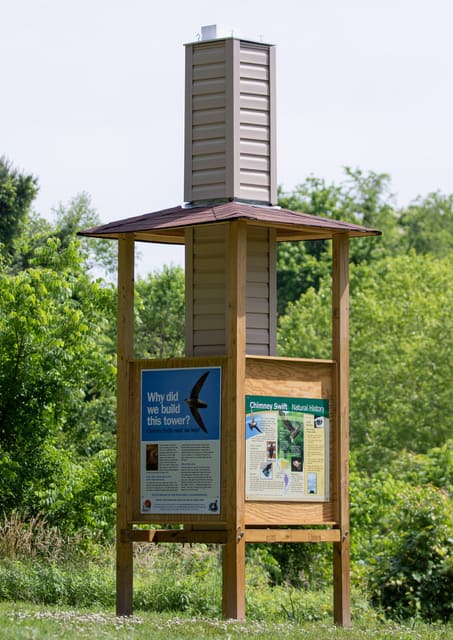Anne Arundel Bird Club sets sights on saving swifts

By Matthew Liptak
A strange new landmark may catch your eye next time you visit Kinder Farm Park in Millersville. It looks like a chimney but it’s not for cooking or heating—it’s for nesting.
Local and national populations of a little bird called the chimney swift are in steep decline. The speedy aerial insectivore is a beneficial bird that feasts on mosquitoes and other biting insects. So, in an effort to boost their numbers, the Anne Arundel Bird Club, the Maryland Bird Conservation Partership and volunteers at Kinder Farm Park joined forces to erect a chimney swift tower in hopes of attracting a breeding pair.
“What I’m hoping is that other bird clubs will get inspiration to put these up throughout the state,” said Chris Eberly, ornithologist and club president. “The more the merrier!”
Almost a third of the U.S. population of aerial insectivores, including swallows, swifts, and nightjars, have died off since 1970. The loss of swifts alone is truly alarming: a 65 percent decline since 1970.
There appear to be multiple causes of the decline, but Eberly says the biggest culprit is the heavy use of insecticides in society, which has seriously lowered insect populations. He points to a simple experiment to prove his point. “You can drive your car and there are hardly any bugs on your windshield anymore,” he said. “Anything that eats these (insects) are going to be hurt.”
One breeding pair of swifts will nest in a tower, chimney or hollow tree trunk. Chimneys are routinely capped nowadays, denying the birds entry to nesting locations. Sometimes chimney sweepers destroy the nests. At the current rate of decline chimney swifts will lose another 50 percent of their population by 2050.
Towers like the one now standing in Kinder Farm can help with the problem. Swifts are often unable to build their nests on flues whose surfaces are too smooth. The nesting tower is lined with grooved plywood to which the swifts can use their saliva to glue twigs into their traditional crescent-shaped nests.
“I found it to be a very interesting project,” said Peter Bungay, who spearheaded the project for the club. “They are really very unusual birds. It was very satisfying. It has a very important educational component.”
The tower itself is 14 inches square inside and 12 feet high. The surrounding kiosk contains graphics designed to inform visitors on the plight of the swift and their peculiar natural history. Swifts evolved to rest solely on vertical surfaces, they do not perch on limbs and are helpless on the ground. Once they leave the chimney nest in the morning, they fly all day, coming back only to feed the babies, until it’s time to roost at dusk. Chimney swifts are daytime migrants. They gather in huge numbers to migrate, roosting in large chimneys on their way to the Amazon basin, where they spend the winters.
A surveillance camera is being installed inside the tower so that the birds and their chicks can be viewed on cellphones without interfering with the nesting activity.
David Barry, a Kinder Farm Park volunteer, was able to put the park’s wood workshop and sawmill to use in the actual construction of the chimney swift tower. “Another construction experience in the park—a little bigger than usual,” Barry says. He likes birds, but also just enjoys working with wood. He’s motivated by “making saw dust and putting things together.”
About five volunteers worked on the tower, and park rangers would occasionally stop by.
The tower was erected and dedicated on June 28 to the memory of former bird club recording secretary Judith Brennan.
The bird club continues to accept donations for the chimney swift tower initiative. Bungay said 48 people have donated so far and a few have offered to cover the costs so that a tower could be dedicated to a loved one.
Currently there are hopes to erect another tower in Quiet Waters Park in Annapolis, but the exponentially increasing price of construction material nationwide has put that on hold for the moment. The price has gone from about $3,000 to $12,000, Bungay said.
To donate: aabirdclub.org.
